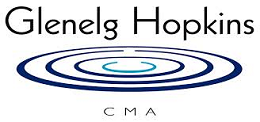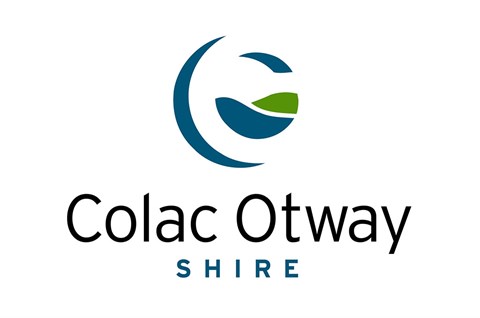
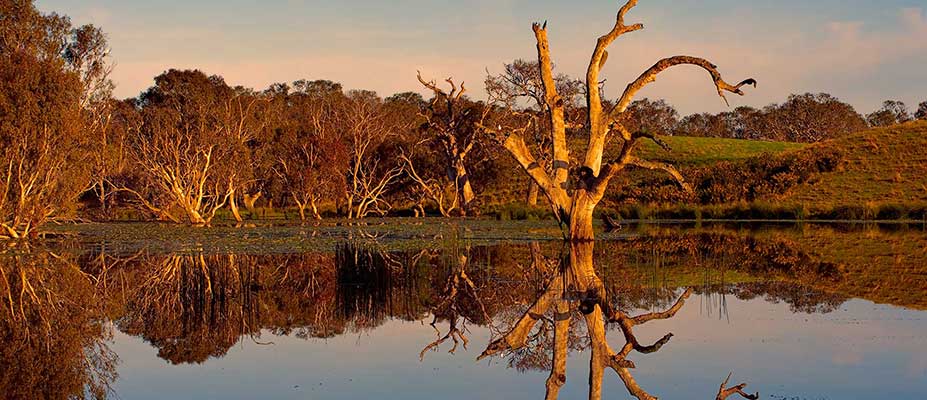
South West Climate Change Portal
The South West Climate Change Portal provides tools, maps, and visualisations to enable stakeholders to understand and plan for climate change in the south-west region of Victoria. It represents a collaboration between Corangamite and Glenelg Hopkins Catchment Management Authorities, and the councils of the Great South Coast (under the Climate Resilient Communities of the Barwon South West project), in partnership with CeRDI.
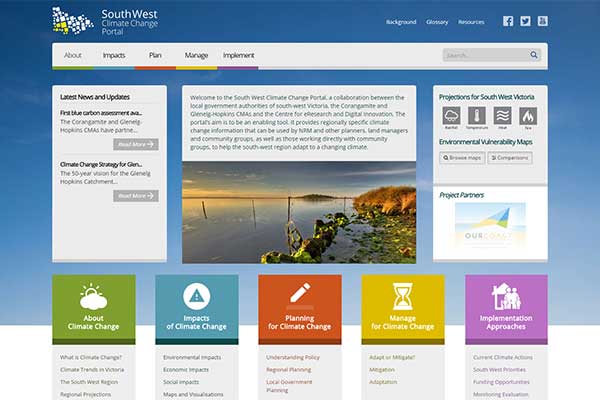 |
Background
The South West Climate Change Portal was initiated as part a larger collaborative project between two Catchment Management Authorities (CMA) and 10 local government agencies (LGA) to make relevant and unique spatial information readily accessible to councils, government organisations and communities, some of it not available elsewhere. It forms part of CMA and LGA planning for climate change, which are underpinned by the Australian Government’s NRM (Natural Resource Management) planning for climate change fund and the Victorian Adaptation and Sustainability Partnership.
The South West Climate Change Portal offers a host of information and resources – including planning tools, maps, and visualisations - to enable communities to prepare and plan for the impacts of climate change.
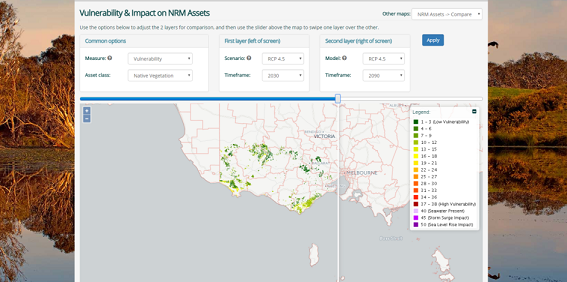 |
The portal has been designed specifically for natural resource managers, local planners, land managers and other regional organisations who are working closely with local communities to respond to the current and future threats posed by climate change.
The portal provides:
- Regional information on the projected changes in climate and its likely impact on the region’s economic, social, and environmental assets;
- Guidance in developing adaptation and mitigation actions to address the impact of climate change on the region’s economic, social, and environmental assets;
- Identification of priority landscapes for carbon plantings and other carbon sequestration methods, as well as strategies to build landscape integrity; and
- Guidance for regional decision-making, community engagement and research need to improve understanding of the impact of climate change, and how we can manage those impacts.
The project is the culmination of an extensive body of work by the project partners including the local government authorities in the southwest region of Victoria (the Climate Resilient Communities of the Barwon South West project), the Victorian Government and the Corangamite and Glenelg-Hopkins Catchment Management Authorities (CMAs).
Outcomes
Comprehensive information and data are available to examine the predicted impacts of climate change. The portal also provides links to government policies pertaining to climate change and provides tools to support regional climate change planning and management. Resources and funding information to support both adaption and mitigation approaches to climate change are also available.
The maps and visualisations available on the South West Climate Change portal provide an important source of information to guide community discussion around future planning. The portal provides a unique resource for the region: The spatial maps and visualisations provide a valuable resource to assist with local decision making. They enable comparison of climate change scenarios. The regional maps also identify vulnerability and impact layers that can be used by communities and regional planners in planning for mitigating threats associated with climate change.
Innovation
The South West Climate Change Portal adopts an innovative and interactive approach to communicating spatial data and climate change-related information relevant to communities in the south-west region of Victoria. It combines engaging yet simple visualisation tools and written content to convey the relevance of climate change to local communities and equip them with the knowledge and resources to prepare and plan.
It draws upon current modelling of climate change vulnerability and sensitivity of the region’s natural assets, to give end users detailed spatial information on anticipated changes that might impact their local environment.
Technical Features
Novel approaches to comparing the impacts of climate change on natural assets have been employed. The ability to ‘swipe’ one layer over the top of another to compare scenarios as shown in the animation below.
 |
Additionally, the ability to visualise multiple scenarios by animating between layers over time is a powerful way for the user to interact with the data. Animations are dynamic, allowing the user to zoom and pan to an area of interest and the relevant data will be loaded into the web map service (WMS) animation framework.
Approach
The South West Climate Change Portal combines spatially- and regionally relevant information in a selection of online tools to rapidly communicate predicted climate change impacts on natural and municipal assets.
Spatial information is based upon several sources including Spatial Vision’s modelling of vulnerability and sensitivity of natural assets, SimCLIM modelling of regional social, economic, and environmental climate vulnerability, and climate analogues developed for southern Victoria by CSIRO.
The portal features the latest climate change planning information for the region. This includes the climate change strategies and plans for the Climate Resilient Communities of the Barwon South West, and Corangamite and Glenelg Hopkins CMAs. It also features links to Adaptation Pathways, a planning tool for addressing the uncertainty and challenges of climate change decision-making.
Future Directions
Regional stakeholders will continue to update and expand the portal content in the future. There may be opportunities to expand the portal research and engagement model to other geographical regions where the impacts of climate change on the environment, local communities and the economy are expected to be high.
Future CeRDI research will examine how access to the South West Climate Change Portal guides decision making and changes stakeholder and community practice.
-
NEWS
South West Climate Change Portal launch - 9 June 2016
A new website, the South West Climate Change Portal, has been launched to enable climate change planning for the south west region of Victoria.... Continue reading...
-
PARTNERS
Colac Otway Shire

(on behalf of the Local Councils of the Victorian Great South Coast region)


